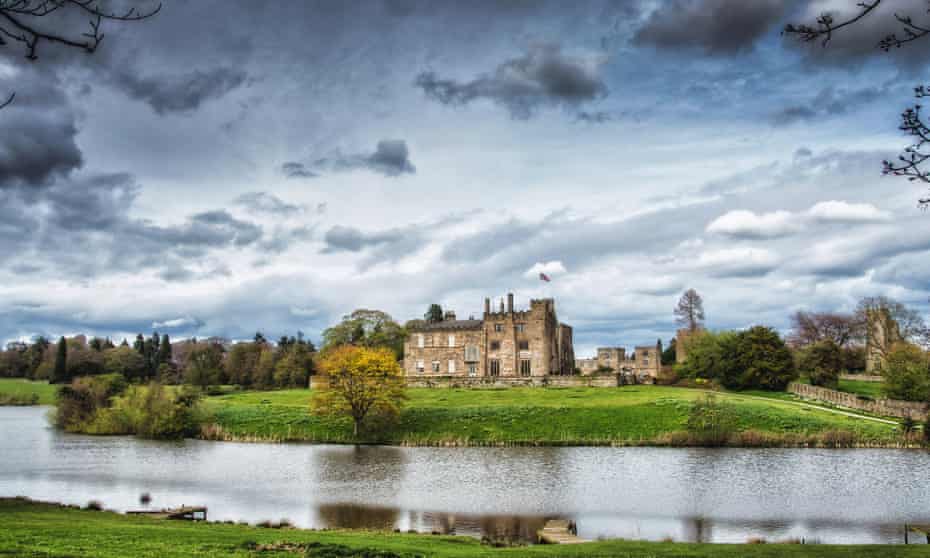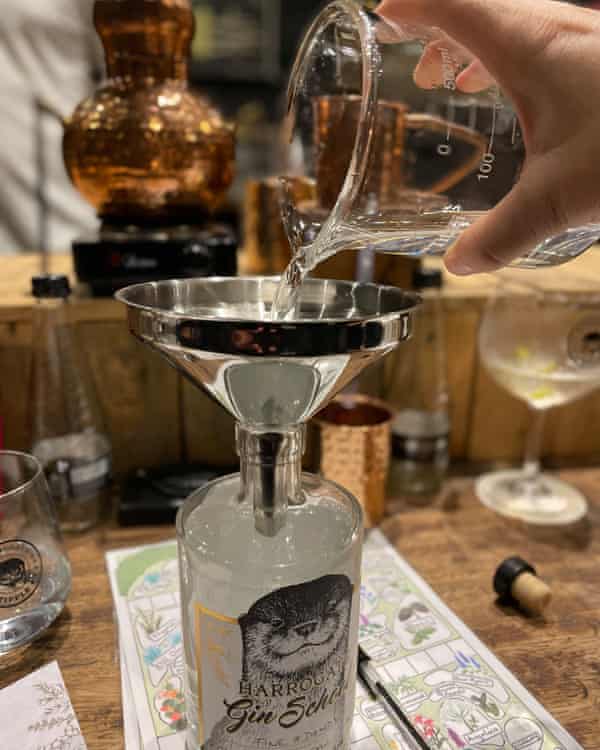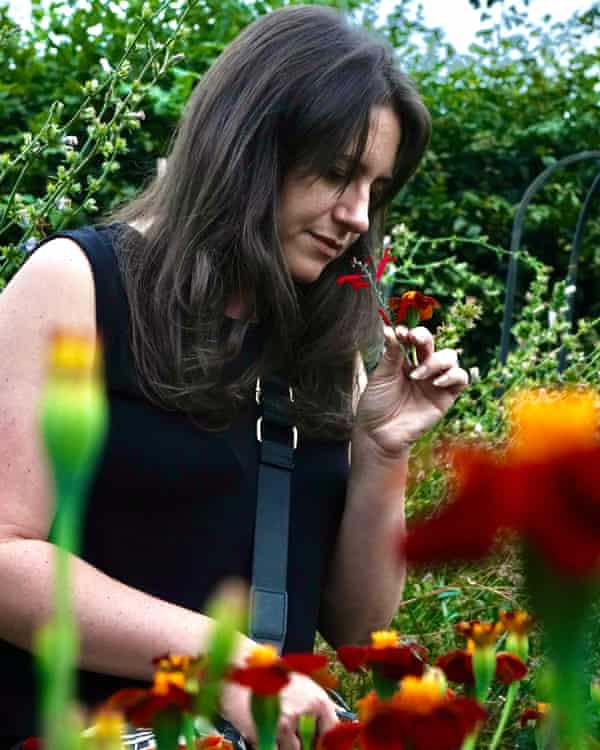‘It’s about to happen, I promise!” says Rob Crossley, the “Professor”, as he uses asbestos fingers to gingerly tip-tap his way along a copper pipe to where the magic is to begin. When the heat spreads all the way down to the spindly tip, he knows the temperature will be right for the drip to start.
This hand-hammered copper pot, with its bulging belly warmed by a small electric hob, looks a lot like something from a Harry Potter potion-making class. Which is fitting, because I’m inside the walls of a castle – it’s just that I’m making gin rather than polyjuice. Having been a member of the gin fanclub way longer than it’s been fashionable, it feels overdue that I’m learning to make my own (along with 11 other eager students).
After the relaxation of licensing laws that spawned a boom in craft distilleries, gin schools have popped up across the UK in the past five years. This one, run by Harrogate Tipple, is in a particularly impressive location, though. A long, vaulted window to my right neatly frames a square, crenulated turret of Ripley Castle’s east wing, with a circular gravel drive in the foreground and fields in the distance. And to get to the charcoal-walled gin-making room, I entered through a fake wall in the gin shop, the door handle disguised as an unassuming porcelain bottle on a bookshelf.

The gin school is Ripley Castle’s latest move to diversify the estate’s revenue streams. The castle is already home to quad-biking, archery, body-zorbing, outdoor treasure hunts and indoor escape rooms.
“These places are incredibly expensive to run,” says Lady Emma Ingilby, whose business-and-marketing nous has helped keep the estate afloat over the past three decades. “Our business strategy has focused on the village, to make it a destination.”
On the weekend of my visit, it’s clear how successful the Ingilbys have been. The village is full of concert-goers who’ve come for a gig overlooking the castle’s lake and deer park, and there’s music in the air.

On the edge of the Dales and less than four miles from Harrogate, Ripley is as chocolate box as they come. Sandstone-coloured Georgian townhouses framing a cobbled square where locals, tourists, hikers and bikers commune over pints from the ivy-clad Boar’s Head inn, where I’m staying. There’s a reason it’s all so uniformly pretty. On a whim, in the 1800s, the Lord Ingilby of the day decided to remodel Ripley on a French village. The Ingilbys have resided at Ripley for more than 700 years and until 1974 when the current Lord Ingilby inherited, 80% of the village still belonged to the estate.
Our gin-making evening began earlier at Harrogate Tipple’s distillery in the village with an introduction to the stills, Zac and Cassie, named after two of the owner’s children, and a brief rundown of the history of gin and the history of the distillery. The gin school has been years in the making. The distillery’s founder, Steven Green, is a cameraman who has travelled the world shooting film. His heart, however, was always in North Yorkshire and Harrogate Tipple – launched in 2018 – was conceived as a way to keep it here. Steve poured his Hollywood patter into the distillery and it was soon producing Downton Abbey’s official gin (yep the TV drama has its own tipple). “If you put a pin on the map of England where Downton is set, it’s exactly where we are,” he told me at the time.
The gins have now won several accolades but Steve’s masterplan always included a gin school. Its intended home was a Victorian hothouse in Ripley Castle’s walled gardens. Then something happened. “We put in new plumbing, new electrics, we replaced 36 panes of glass, and then the roof started falling in,” says Green. After that the pandemic hit and the distillery spent months churning out hand sanitiser. It’s only recently that the school has finally got off the ground.

One thing that sets Harrogate Tipple’s school apart is the fact that participants get to venture into the castle’s walled gardens to pick fresh botanicals. Lady Emma has leased the distillery a 30sq m plot, along with a hothouse for winter, and it now has about 140 plants and flowers at its fingertips, along with honey from Lady Emma’s beehives.
Over a gooseberry G&T, I scour my booklet of fresh botanicals, each listed with a flavour profile and recommended quantity. Do I want lovage (“citrus celery, with a hint of anise”) in my gin? Or how about Lady Plymouth (“rose and mint dancing together”)? And would wormwood (“the bitterest of herbs”) throw everything off balance? “There is no right or wrong answer,” says Rob as we head off into the castle gardens with cotton bags, scissors and hand-illustrated garden maps.
“Get stuck in. Smell stuff, rub stuff,” he instructs. Each plant is a revelation. I discover feather-edged, herby pelargoniums, which taste different depending on the variety. There’s glossy lime leaves with an unmistakable pepperiness, and fluffy bronze fennel that smacks of aniseed, but laced with notes of intense sweetness that I hadn’t expected.
Back inside we weigh dry ingredients like lemon verbena and oats, grind coriander seeds and nuts such as hazel and almond and choose from the leaves we’ve picked. It all goes into our own 1L copper stills, along with a prepared base of juniper and classic botanicals like cassia bark and angelica root (so that proceedings don’t go too awry), and a base alcohol akin to vodka. The stills are heated and we wait, giddy with anticipation.

Remarkably, the process from heating the liquor to bottling the end product, diluted with Harrogate spring water to bring it down to about 40% ABV, only takes about an hour.
The gin I end up with, dripped out over more G&Ts with boisterous music and chatter, is a personalised expression of the Yorkshire gardens I’ve been exploring. But it’s also a reflection of my palette and I’m pleasantly surprised to find I love it. It’s heavy on the coriander, extremely herbacious and savoury – perhaps not everyone’s cup of tea, but it’s exactly what I want to drink. Could this revolutionise my drinking habits? The ingredients and quantities are recorded and logged by the distillery in case I want to reorder. I already feel as if I might.
The trip was provided by Harrogate Tipple; its three-hour gin-making experience costs £125pp, including a 50cl personalised bottle of gin. Doubles at the Boar’s Head from £100 room-only





